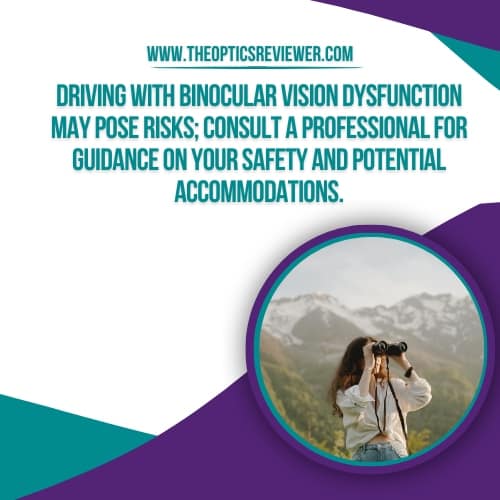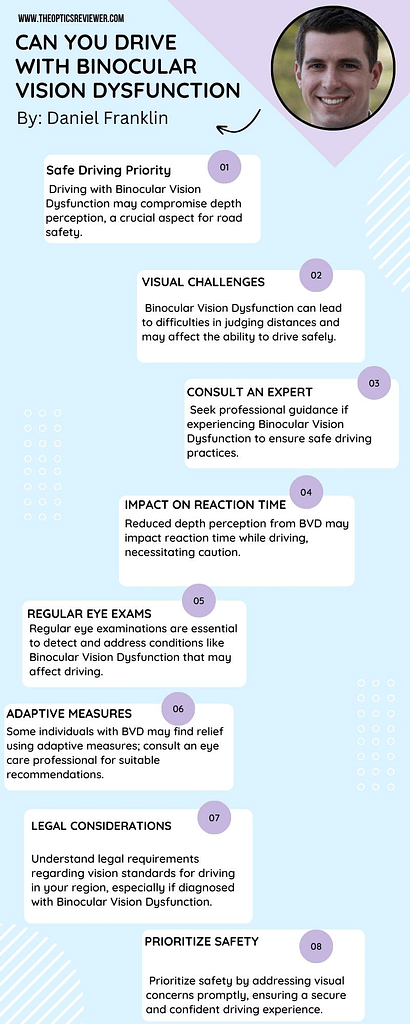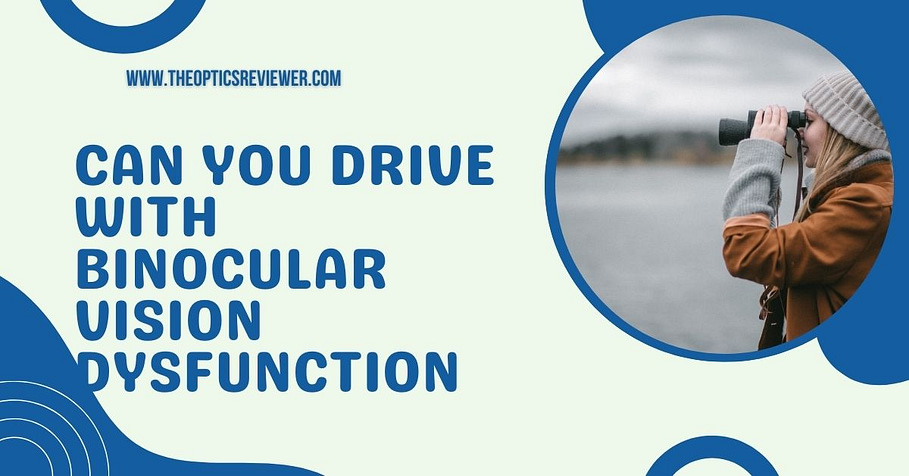Navigating the open road is an everyday freedom for many, but for those grappling with binocular vision dysfunction, the journey takes on a new level of complexity. The question arises: Can you drive with binocular vision dysfunction? As we delve into this inquiry, we unlock the intersection between visual health and the driver’s seat. Binocular vision dysfunction, a condition impacting the coordination of both eyes, can cast shadows on depth perception and visual alignment.
In this exploration, we uncover the implications for those contemplating a drive with this condition, unraveling the critical considerations and potential challenges that may influence one’s ability to confidently take the wheel. Join us on this exploration of the road less traveled, where vision meets the highway, and safety takes center stage.
Contents
- 1 Key Takeaways
- 2 What Does Binocular Vision Dysfunction Mean?
- 3 What are the Symptoms of Binocular Vision Dysfunction?
- 4 Can You Drive With Binocular Vision Dysfunction?
- 5 How Binocular Vision Dysfunction Can Make It Harder To Drive At Night?
- 6 Signs That Binocular Vision Dysfunction Could Be Affecting Your Ability To Drive
- 7 What are the Symptoms of Binocular Vision Dysfunction?
- 8 What are Some Treatment Options For Binocular Vision Dysfunction?
- 9 Conclusion
- 10 References
- 11 Frequently Asked Questions
- 11.1 Is Binocular Vision Dysfunction a Common Condition?
- 11.2 Are There Any Specific Driving Restrictions for Individuals With Binocular Vision Dysfunction?
- 11.3 Can Wearing Glasses or Contact Lenses Help Improve Vision for Those With Binocular Vision Dysfunction While Driving?
- 11.4 Are There Any Specific Exercises or Therapies That Can Help Improve Binocular Vision Dysfunction for Driving Purposes?
- 11.5 Are There Any Specific Safety Tips or Precautions That Individuals With Binocular Vision Dysfunction Should Follow While Driving?
Key Takeaways
- Binocular Vision Dysfunction can hinder safe driving, especially at night.
- Impaired depth perception makes judging distances difficult while driving.
- Seeking evaluation and interventions can enhance road safety for those with BV Dysfunction.
- Comprehensive vision testing is crucial for safe driving with BV Dysfunction.
What Does Binocular Vision Dysfunction Mean?
Binocular Vision Dysfunction refers to a condition in which both eyes are unable to work together properly to achieve clear and comfortable vision. This impairment can lead to difficulties in depth perception, causing symptoms like double vision, eyestrain, headaches, and dizziness. Ocular misalignment is a common issue associated with this condition, where the eyes fail to coordinate and align correctly. Vision therapy, a specialized program designed to improve binocular vision function, often involves a series of eye exercises to enhance eye coordination and focus.
Additionally, prism glasses may be prescribed to help align the images seen by each eye, aiding in the fusion of visual information. By addressing these underlying visual issues through vision therapy and corrective lenses, individuals with Binocular Vision Dysfunction can experience improved visual comfort and overall quality of life. It is crucial for individuals experiencing symptoms of Binocular Vision Dysfunction to seek an eye care professional for a comprehensive evaluation and tailored treatment plan.
What are the Symptoms of Binocular Vision Dysfunction?
Individuals with Binocular Vision Dysfunction may experience a range of symptoms that indicate challenges in visual coordination and depth perception. Some common symptoms include eye strain, double vision, and difficulties with depth perception. These symptoms can significantly impact daily activities such as driving, reading, or playing sports. Recognizing these signs early is crucial for seeking appropriate interventions like vision therapy and visual exercises to improve binocular vision.
To provide a clearer understanding, the table below outlines the key symptoms associated with Binocular Vision Dysfunction:
| Symptom | Description |
|---|---|
| Eye Strain | Feeling of discomfort or fatigue in the eyes after prolonged visual tasks. |
| Double Vision | Seeing two images of a single object either side-by-side or overlapping. |
| Depth Perception | Difficulty judging distances between objects accurately, affecting activities like driving. |
Identifying these symptoms and seeking professional help, such as through vision therapy, can aid in managing Binocular Vision Dysfunction effectively, enhancing overall visual function and quality of life.

Can You Drive With Binocular Vision Dysfunction?
Driving with Binocular Vision Dysfunction presents challenges due to impaired depth perception and visual coordination. Individuals with this condition may find it more difficult to drive safely and effectively, especially in certain situations like night driving. Here are some key points to consider:
- Night driving can be particularly challenging for individuals with Binocular Vision Dysfunction due to reduced visual acuity in low-light conditions. The lack of proper depth perception can make it harder to judge distances accurately, leading to potential safety risks.
- Vision therapy can offer significant benefits for individuals with Binocular Vision Dysfunction. This specialized treatment aims to improve visual coordination and depth perception, enhancing overall visual function and making driving safer and more manageable.
- Depth perception is crucial for safe driving. It allows individuals to accurately judge the distance between their vehicle and other objects on the road, helping to prevent accidents and ensure smooth navigation. Maintaining awareness of one’s visual field is essential for safe driving, especially for those with Binocular Vision Dysfunction.

How Binocular Vision Dysfunction Can Make It Harder To Drive At Night?
Night driving poses heightened challenges for individuals with Binocular Vision Dysfunction, exacerbating the already compromised depth perception and visual coordination associated with the condition. Visual impairment from Binocular Vision Dysfunction can lead to difficulties in judging distances accurately, making it challenging to navigate the road at night. Depth perception issues can cause problems with distinguishing objects and their proximity, impacting the ability to react swiftly to changes in the environment.
Glare sensitivity, common in individuals with this condition, can be particularly troublesome when encountering bright headlights or streetlights, further impeding visibility during nighttime driving. Moreover, peripheral vision limitations inherent in Binocular Vision Dysfunction can reduce awareness of surrounding vehicles and obstacles, increasing the risk of accidents when driving in low-light conditions. These combined factors underscore the significant hurdles that individuals with Binocular Vision Dysfunction face when driving at night, emphasizing the importance of seeking appropriate evaluation and potential interventions to enhance road safety.
If interested you can read more about can you use binoculars with glasses.
Signs That Binocular Vision Dysfunction Could Be Affecting Your Ability To Drive
Driving requires precise visual coordination, and binocular vision dysfunction can significantly impact this crucial skill. Recognizing signs that your ability to drive may be affected is essential for your safety and the safety of others on the road.
- Double Vision:
- If you frequently experience double vision while driving, it could be a sign of binocular vision dysfunction. This visual issue can make it challenging to accurately perceive the distance between objects.
- Eye Strain and Fatigue:
- Struggling with eye strain or fatigue, especially during or after driving, may indicate underlying vision problems. Binocular vision dysfunction can lead to discomfort and exhaustion due to the extra effort required for visual coordination.
- Difficulty Judging Distances:
- Impaired depth perception is a common symptom. If you find it challenging to judge distances between your vehicle and others, or misjudge the space required for maneuvers, it may be linked to binocular vision issues.
- Frequent Headaches:
- Persistent headaches, especially after driving, could be a signal of visual strain associated with binocular vision dysfunction. The eyes may be working harder to align properly, leading to discomfort.
- Light Sensitivity:
- Increased sensitivity to light, known as photophobia, may be linked to vision issues. Glare from headlights or bright sunlight can exacerbate discomfort for individuals with binocular vision dysfunction.
- Reduced Night Vision:
- Difficulty seeing clearly at night or experiencing increased challenges when driving in low-light conditions can be indicative of binocular vision dysfunction affecting your ability to adapt to varying light levels.
- Inconsistent Depth Perception:
- If you notice inconsistencies in judging the depth of objects or struggle with parking, especially in tight spaces, it may be a result of compromised depth perception linked to binocular vision dysfunction.
What are the Symptoms of Binocular Vision Dysfunction?
Binocular Vision Dysfunction (BVD) can manifest in various ways, impacting the way our eyes work together. Recognizing the symptoms is crucial for timely intervention.
- Eye Strain and Fatigue:
- Individuals with BVD often experience persistent eye strain, fatigue, or discomfort, especially after activities requiring prolonged visual focus.
- Headaches and Dizziness:
- Frequent headaches and episodes of dizziness may indicate difficulties in aligning and coordinating the eyes properly.
- Double Vision:
- Seeing double, either occasionally or consistently, is a common symptom. This can occur at various distances and significantly affect daily activities.
- Difficulty with Concentration:
- BVD can impact concentration, making tasks that require sustained visual attention challenging. This may affect academic or work performance.
- Depth Perception Issues:
- Impaired depth perception can lead to difficulties judging distances accurately, potentially impacting activities like sports or driving.
- Intermittent Blurred Vision:
- Vision clarity may fluctuate, with intermittent episodes of blurred or unstable vision, especially during visually demanding tasks.
- Tilting or Turning of the Head:
- Some individuals may unconsciously tilt or turn their head to find a more comfortable and stable visual position.
- Difficulty Reading or Watching Screens:
- Challenges with reading, focusing on screens, or following lines of text may indicate underlying binocular vision issues.
If interested you can read more about who makes cabelas binoculars.
What are Some Treatment Options For Binocular Vision Dysfunction?
Treatment options for Binocular Vision Dysfunction typically involve a combination of vision therapy and specialized eye exercises to improve visual coordination and alleviate symptoms. When addressing Binocular Vision Dysfunction, various treatment modalities can be employed to enhance binocular vision and overall visual function. Some common treatment options include:
- Vision Therapy: This involves a personalized program of eye exercises and activities designed to improve eye coordination and strengthen the eye muscles, ultimately enhancing binocular vision.
- Prism Glasses: Prism glasses can be prescribed to help align the eyes properly and reduce double vision by altering the perceived direction of light entering the eyes.
- Patching Therapy: Patching therapy may be recommended to strengthen the weaker eye in cases of amblyopia (lazy eye) associated with Binocular Vision Dysfunction.
These treatment approaches, along with interventions such as neuro optometric rehabilitation, aim to address the underlying causes of Binocular Vision Dysfunction and optimize visual outcomes for individuals experiencing visual challenges.
If interested you can read more about are 80×80 binoculars good.
Conclusion
In conclusion, the question Can you drive with binocular vision dysfunction underscores the critical importance of prioritizing road safety. Individuals experiencing binocular vision dysfunction should exercise caution and refrain from driving until they have consulted with a qualified eye care professional. Safety on the road requires optimal depth perception and visual coordination, which may be compromised by this condition.
Prioritizing the well-being of oneself and others on the road is paramount. Seeking timely diagnosis and appropriate treatment not only ensures personal safety but contributes to the overall safety of the driving community. Let’s drive responsibly and prioritize our vision health to create safer roads for everyone.
References
- https://link.springer.com/article/10.1007/BF00235723
- https://link.springer.com/article/10.1007/BF00233186
- https://link.springer.com/article/10.1007/BF00237700
- https://link.springer.com/article/10.1007/BF00248796
Frequently Asked Questions
Is Binocular Vision Dysfunction a Common Condition?
Binocular vision dysfunction is a prevalent condition that affects individuals differently. Treatment options include vision therapy and prism lenses. Symptom management is crucial for driving skills, as visual impairments can impact depth perception and peripheral awareness, warranting caution on the road.
Are There Any Specific Driving Restrictions for Individuals With Binocular Vision Dysfunction?
Individuals with binocular vision dysfunction may face challenges while driving, especially at night. Issues with peripheral vision, glare sensitivity, depth perception, and reaction time could impact safe driving. Consultation with a vision specialist is recommended for personalized advice.
Can Wearing Glasses or Contact Lenses Help Improve Vision for Those With Binocular Vision Dysfunction While Driving?
Studies show that vision therapy can improve depth perception and peripheral vision for individuals with binocular vision dysfunction. Contact lenses may assist in enhancing visual acuity, particularly useful for night driving. Consult an optometrist for personalized recommendations.
Are There Any Specific Exercises or Therapies That Can Help Improve Binocular Vision Dysfunction for Driving Purposes?
Vision therapy and targeted eye exercises can enhance depth perception, expand the visual field, and improve peripheral vision in individuals with binocular vision dysfunction, potentially aiding in driving ability. Consult a vision specialist for personalized treatment.
Are There Any Specific Safety Tips or Precautions That Individuals With Binocular Vision Dysfunction Should Follow While Driving?
Night driving with binocular vision dysfunction requires caution due to compromised depth perception and peripheral vision. Glare sensitivity can be heightened, impacting visibility. Individuals must compensate by maintaining increased following distances, reducing speed, and being vigilant to maintain safe reaction times.

